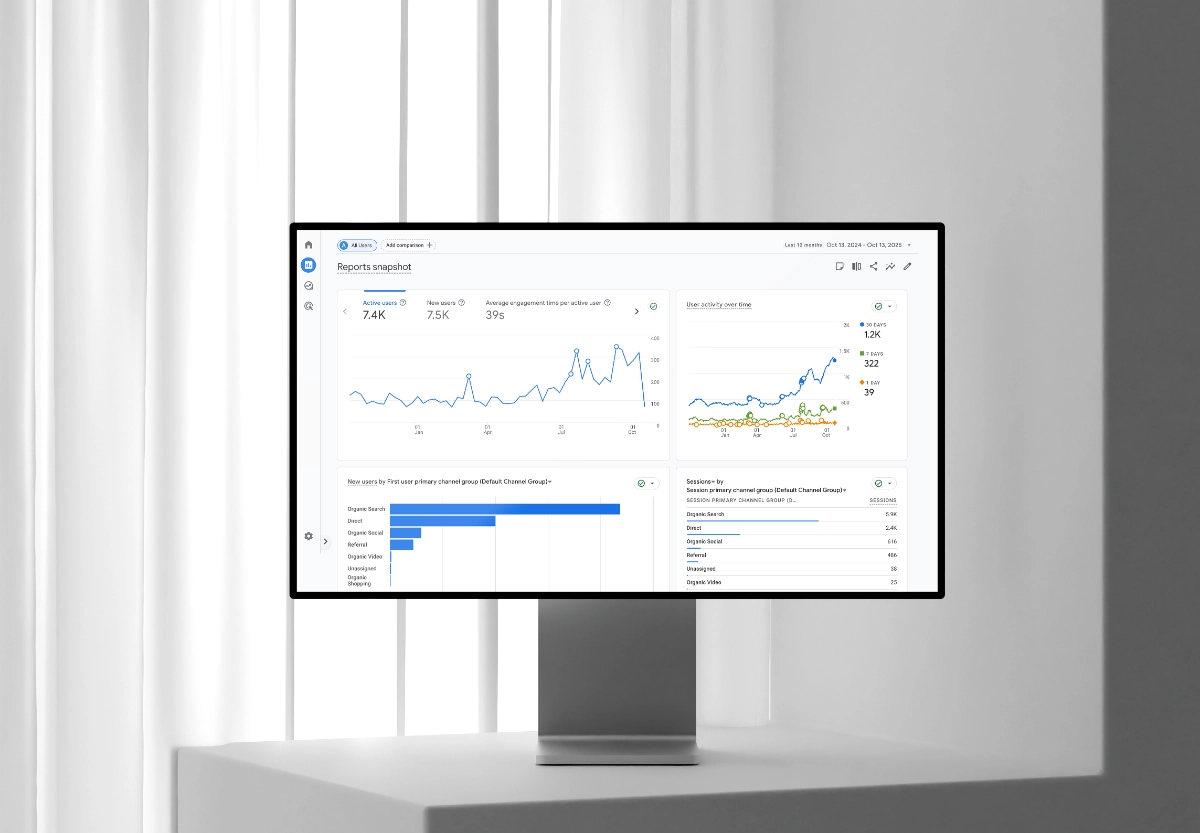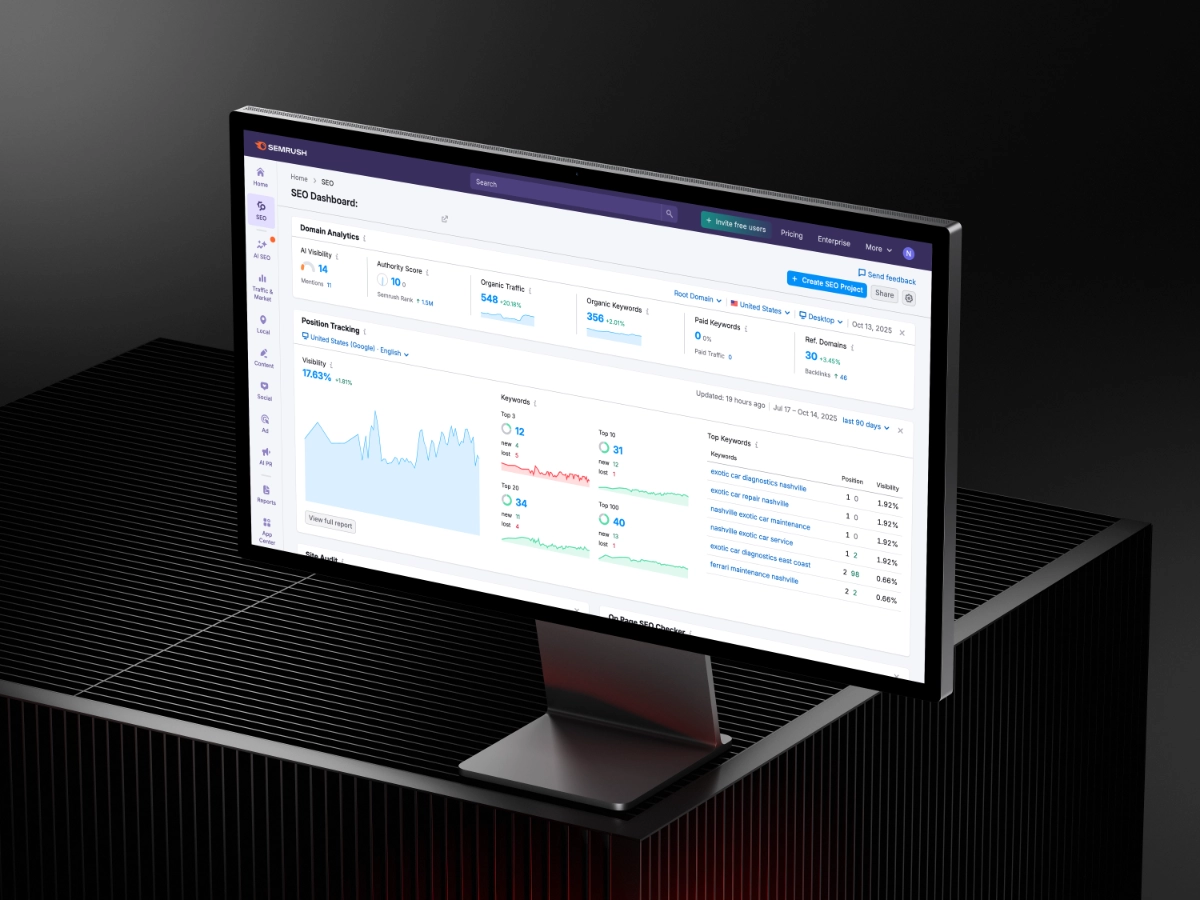The Complete Guide to Webflow SEO: How to Optimize Your Site for Rankings and Conversions
By Nicholas Reed
October 14, 2025

If you're building a website with Webflow, you've already made a smart choice for design flexibility and visual control. Aside from design, as a Webflow SEO agency, we love the platform for how well we can optimize your Webflow site for search engines.
Thankfully Webflow is inherently SEO-friendly—but knowing how to leverage its built-in features and best practices can mean the difference between page one rankings and digital obscurity.
This comprehensive Webflow SEO guide will walk you through everything you need to know to optimize your site for both search rankings and conversions, from technical setup to advanced strategies.
Why Webflow is Built for SEO Success
Unlike many website builders that treat SEO as an afterthought, Webflow was designed with search optimization in mind. The platform generates clean, semantic HTML code that search engines can easily crawl and index. Unlike WordPress sites bloated with plugins, Webflow delivers fast-loading pages without unnecessary code overhead.
As a Webflow SEO agency, we've seen firsthand how sites built on this platform can outperform competitors when properly optimized. The platform gives you granular control over every SEO element while maintaining the design flexibility that makes Webflow special.
Technical SEO Foundation: Setting Up Your Webflow Site Right
Clean URL Structure
Webflow automatically generates clean, readable URLs based on your page names. However, you should customize these to include target keywords naturally. Navigate to your page settings and edit the slug to create URLs like /webflow-seo-services instead of /page-1.
Best practices for Webflow URLs:
- Keep URLs short and descriptive
- Include your primary keyword
- Use hyphens to separate words
- Avoid unnecessary parameters or numbers
- Create logical hierarchy for subpages
XML Sitemap Configuration
Webflow automatically generates and updates your XML sitemap at yourdomain.com/sitemap.xml. This sitemap is automatically submitted to search engines when you publish changes, ensuring fast indexing. However, you should verify your sitemap in Google Search Console to monitor indexing status and identify any crawl errors.
SSL and HTTPS
Security is a ranking factor, and Webflow includes SSL certificates on all paid hosting plans. Ensure your site is serving over HTTPS, which not only protects user data but also signals trustworthiness to search engines. This is automatically configured when you connect a custom domain.
Mobile Responsiveness
With mobile-first indexing, Google primarily uses the mobile version of your site for ranking. Webflow's responsive design capabilities ensure your site looks great on all devices, but you should test thoroughly. Use Webflow's built-in breakpoint system to optimize layouts, font sizes, and spacing for mobile users.
On-Page SEO: Optimizing Every Element
Title Tags and Meta Descriptions
Every page in Webflow allows you to customize title tags and meta descriptions in the page settings. These elements are critical for both rankings and click-through rates.
Title tag optimization:
- Keep titles under 60 characters
- Include your primary keyword near the beginning
- Make it compelling and click-worthy
- Match search intent for your target keywords
Meta description strategy:
- Write 150-160 characters that entice clicks
- Include target keywords naturally
- Add a clear call-to-action
- Describe the page's value proposition
Header Tag Hierarchy
Proper header tag structure helps search engines understand your content hierarchy. Webflow makes it easy to assign H1, H2, H3, and other heading levels through the style panel.
Use one H1 per page that includes your primary keyword. Structure your content with H2s for main sections and H3s for subsections. This not only helps SEO but improves readability and user experience.
Image Optimization
Images can significantly impact both SEO and site speed. Webflow's Asset Manager makes image optimization straightforward:
- Use descriptive file names before uploading (e.g., webflow-seo-dashboard.jpg instead of IMG_1234.jpg)
- Add alt text to every image through the image settings panel
- Compress images before uploading to reduce file size
- Use responsive images by enabling Webflow's automatic image optimization
- Leverage lazy loading for images below the fold
Webflow CMS and SEO: Dynamic Content Optimization
One of Webflow's most powerful features for SEO is its CMS, which allows you to create dynamic, scalable content that's automatically optimized.
SEO-Friendly CMS Field Setup
When creating CMS collections, build SEO fields into your structure:
- Meta Title field: Create a plain text field for custom title tags
- Meta Description field: Add a plain text field for descriptions
- OG Image field: Include an image field for social sharing
- Slug field: Webflow auto-generates this, but you can customize it
- Structured Data fields: Add fields for schema markup data
Dynamic Meta Tags
Connect your CMS fields to your collection template's page settings. This ensures every blog post, portfolio item, or product page has unique, optimized meta information without manual updates.
Content Strategy for CMS Collections
Whether you're building a blog, case study library, or product catalog, structure your CMS content with SEO in mind. Use rich text fields to allow proper heading hierarchy, add related posts for internal linking, and create category structures that support logical site architecture.
Schema Markup and Structured Data
Schema markup helps search engines understand your content context, potentially earning rich snippets in search results. While Webflow doesn't have built-in schema tools, you can add structured data through custom code embeds.
Key schema types for Webflow sites:
- Organization schema for your homepage
- Article schema for blog posts
- LocalBusiness schema if you serve a geographic area
- Product schema for e-commerce sites
- FAQ schema for informational pages
Add schema markup in JSON-LD format through Webflow's custom code section in page settings or site-wide in the custom code area.
Page Speed Optimization
Site speed is a confirmed ranking factor and crucial for conversions. Webflow sites are generally fast, but optimization is still necessary.
Webflow-Specific Speed Techniques
Optimize asset delivery:
- Enable lazy loading in image settings
- Use Webflow's responsive image system
- Minimize custom code and external scripts
- Defer non-critical JavaScript
Reduce page weight:
- Audit your interactions and animations—complex effects can slow rendering
- Minimize the number of CMS items loaded per page
- Use pagination or "load more" instead of displaying hundreds of items
Leverage Webflow's CDN:
- Webflow automatically serves your site through a global CDN
- Images, CSS, and JavaScript are cached for faster delivery
- Take advantage of this by keeping your site hosted on Webflow
Use Google PageSpeed Insights and Core Web Vitals metrics to identify specific bottlenecks and track improvements.
Internal Linking Strategy
Internal links distribute page authority throughout your site and help search engines discover and understand content relationships. In Webflow, building an internal linking strategy is straightforward but requires intentionality.
Create contextual links within body content using your rich text editor. Link from high-authority pages (like your homepage) to important service or product pages. Build related post sections in your CMS templates to automatically create relevant connections.
Content Optimization for Conversions
SEO isn't just about rankings—it's about driving qualified traffic that converts. Your Webflow site optimization should balance search visibility with conversion rate optimization.
Conversion-focused SEO elements:
- Write compelling headlines that match search intent
- Structure content with clear sections and easy scanning
- Add strategic CTAs throughout long-form content
- Use visual hierarchy to guide users to conversion points
- Optimize forms for mobile completion
Monitoring and Continuous Improvement
Webflow SEO is not a one-time setup—it requires ongoing monitoring and refinement. Connect your site to Google Search Console and Google Analytics 4 through Webflow's integrations panel.
Key metrics to track:
- Organic traffic growth over time
- Rankings for target keywords
- Pages with the highest organic traffic
- Bounce rate and engagement metrics
- Conversion rates from organic traffic
Use this data to identify top-performing content, optimize underperforming pages, and guide your content strategy.
Advanced Webflow SEO Considerations
As you mature your Webflow SEO strategy, consider these advanced tactics:
International SEO: Use Webflow's localization features or Webflow Localization to serve content in multiple languages with proper hreflang implementation.
JavaScript rendering: While Webflow sites are generally crawler-friendly, test complex interactions with Google's URL Inspection tool to ensure proper rendering.
Canonical tags: Prevent duplicate content issues by setting canonical URLs in page settings when needed.
Partner with a Webflow SEO Agency
While Webflow makes SEO accessible, mastering the platform's full potential requires expertise. A specialized Webflow SEO agency brings technical knowledge, proven strategies, and experience optimizing hundreds of sites. They can implement advanced techniques, identify opportunities you might miss, and accelerate your path to page-one rankings.
Conclusion
Webflow provides an exceptional foundation for SEO success, combining clean code, design flexibility, and powerful optimization tools. By following this Webflow SEO guide—from technical setup through advanced strategies—you can build a site that ranks well and converts visitors into customers.
Remember that Webflow site optimization is an ongoing process. Start with the fundamentals: clean structure, optimized pages, and quality content. Then continuously refine based on performance data. With the right approach, your Webflow site can dominate search results in your niche.
Ready to take your Webflow SEO to the next level? Get in touch with our Webflow SEO team and learn how you start driving quality organic traffic to your site today.
Have a question about this resource?
Please take a moment to fill out our form and we will help you out as soon as possible!
Thank you! Your submission has been received!
Oops! Something went wrong while submitting the form.













